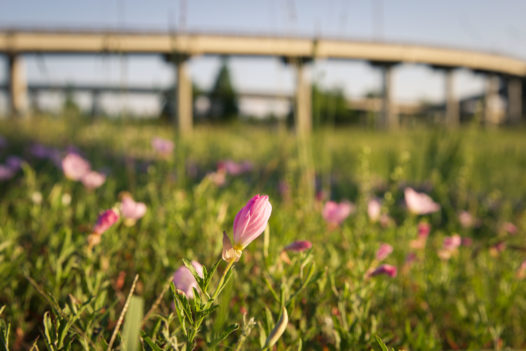Déjà vu draws me to New Orleans East. Where I’m from, the abandoned buildings and ghosts of industry cast long shadows in the afternoon. Empty factories punctuate rust belt cities like Pittsburgh, Chicago, and Detroit. Louisiana, rich instead with the black blood of oil, has many refineries but was never a steel mill state. The vacant structures in New Orleans East are not Carnegie’s legacy, but the result of shifts in economics and population–and natural disaster.

New Orleans East (Photos by: Clare Welsh)
This sounds heavy, and it is. But the blighted, gently thriving consumer architecture has nuance. Given the historic tourism of the French Quarter—the cathedral smelling of sage, the Franco-Spanish balconies laced by cursive, cast-iron railings—the architecture East of the industrial canal is often overlooked by photographers, except those intent on a voyeuristic shot of the storm-torn Six Flags park.
Like their visual cousins, the bleak, HDR-portraits of opiate-sick Appalachia, these bleak, HDR landscapes of Louisiana hurricane damage seem unkind. Why would a photographer want to strip a person or place of pride? A complete photograph captures a duality of vulnerability and strength.
Setting and character are the two pillars of story telling. In architecture photography, the characters that remember and experience the setting are not present, so it’s important to respect their agency. We still have their human traces: the pictures painted, roads driven, and shrines visited.
I would encourage you, reader, not to see New Orleans East as another anonymous stretch of sprawl along one of many arteries supporting our American, car-centric way of life, the I-10. Most people in the East own a vehicle, but getting to work would be impossible with one. As the middle-class moves from the suburbs back into urban centers, a migration that could be called reserve White Flight, culture-bearers get pushed to the city limits. From here, they must commute long distances. New Orleans native John Boutté makes a poignant point about this in an interview here.
This trend is not fair or right, but it might explain why New Orleans East has a pulse that can’t be contained by the big-box templates of its original design. This is not your average sleeper community. Sneakers tucked into stirrups, urban cowboys ride their horses past the CVS. Families fish in a canal. Shaded by a straw hat, a man waters flowers outside of a Vietnamese restaurant. Kids goof in the shadows of an underpass. Thick and green, life bursts from the cracks in pavement. This life, more that the flat devastation of post-mall, post-storm, post-modern, post-whatever-cookie-cutter-lens makes for an easy story, is paramount.
As journalist Mary Ellen Mark said, “Photograph the world as it is. Nothing is more interesting than reality.” We have work to do, but the sky is generous in coastal Louisiana. Light outlines the broken edges; they shine like the wings of birds about to fly.
Clare Welsh is a New Orleans based writer, photographer and illustrator. Her various works have appeared in McSweeny’s, Bayou Magazine, Offbeat, Salt, and Pressure Life. Her book of poems, Chimeras, is available through Finishing Line Press. To follow her work, check out her website at http://clarewelsh.format.com/ or Instagram @clarewelsh.
 NOLAbeings Multimedia artist Claire Bangser created NOLAbeings as a portrait-based story project that marries...
NOLAbeings Multimedia artist Claire Bangser created NOLAbeings as a portrait-based story project that marries...  Voodoo in New Orleans: Reviving history: New Orleans fortune telling This article takes a deep dive into the history of Voodoo in New Orleans, its hybridization with Catholicism, and its present-day place in the city's culture. The author visits fortune-tellers in the French Quarter, using their guidance as a tool for introspection rather than a deterministic predictor of the future. Through her experiences in New Orleans, the author feels a mystical connection to both the past and the future.
Voodoo in New Orleans: Reviving history: New Orleans fortune telling This article takes a deep dive into the history of Voodoo in New Orleans, its hybridization with Catholicism, and its present-day place in the city's culture. The author visits fortune-tellers in the French Quarter, using their guidance as a tool for introspection rather than a deterministic predictor of the future. Through her experiences in New Orleans, the author feels a mystical connection to both the past and the future. 